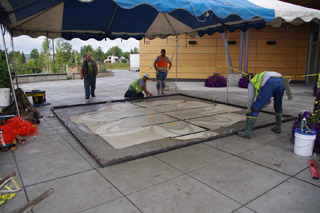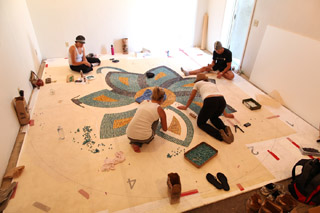|
Subscribe / Renew |
|
|
Contact Us |
|
| ► Subscribe to our Free Weekly Newsletter | |
| home | Welcome, sign in or click here to subscribe. | login |
Construction
| |
 |
May 10, 2012
Mosaics made easy with concrete
Belarde Co.

Belarde
|
Public art plays an important role in municipal and federal construction projects.
It helps creates an identity for the community where the art is placed and ties people and places together. It has become so significant that many public agencies set aside a percentage of funding for public art in their community improvement projects.
A chief challenge agencies have is ensuring that the artwork will be durable. One new technique now offers an excellent opportunity for artists and contractors to work hand-in-hand from design through installation.
New art technique
LithoMosaic allows artists and architects to design vast, handcrafted mosaics that can be set as an integral part of monolithic concrete pours. This technique enlarges the scope, scale, durability and creative freedom of mosaic artwork and combines it with the strength of concrete.
Mosaic is no longer limited by scale, cost, climate or durability. LithoMosaic is a patented process that can be used by artists and architects, and installed by licensed Lithocrete contractors.
Artist Robin Brailsford, co-creator of this technique, came across this system after incorporating mosaic artwork into a public works project involving concrete pavers in Santa Monica, Calif. She immediately saw ways to get this same result on a larger scale.
Brailsford knew she would not be able to do all the labor herself for the type and scale of concrete installation she envisioned. She contacted the creator of Lithocrete, an architectural concrete product, and they together developed LithoMosaic.
Installation
While the artistic and design portion of the work can be very time consuming, the actual installation is as quick as pouring a piece of sidewalk, with a few extra important steps, of course.
It starts with the project team — including the artist, concrete contractor and the architect or landscape architect — working together to identify the proper specification, design intent, color and tile selection, and other details that must be worked out. Once the artist has the design intent, he or she can begin the studio work, beginning with the mosaic tile placement and enlarging the design to the desired size.
The artist then lays out a piece of mesh on top of the enlarged design and begins gluing on the tiles one by one, color by color. Depending on the scale of the artwork and the design layout, this process can take anywhere from four to 16 weeks or more.
Once all the tiles are laid out, glued and dried, the pieces are either shipped or delivered very carefully so as not to lose any tiles en route. The artwork is then handed off to the concrete contractor for installation.
LithoMosaic works well as outdoor public art for a couple of reasons. The first is obvious: Concrete is one of the strongest material forms that we build with. We now have the ability to combine beautiful, vibrant, handcrafted mosaic artwork with the long-lasting characteristics of concrete.
Now, not only are specifications written to create durable concrete, the very same specs are used to create durable artwork. This artwork can be installed in virtually any space you would install concrete: sidewalks, crosswalks, benches, walls, tilt-ups and bridge decking.
Some job site conditions are outside our control and are difficult to anticipate. A major advantage of this type of decorative concrete installation is that all the artwork is created in the controlled environment of the artist’s studio. Any potential problems or issues that arise are easily corrected there.
A tested process
The LithoMosaic process has undergone rigorous testing to determine how best to use it. An optimal step-by-step installation method has been developed, including which tile materials work best and which additives are needed in the concrete. All licensed contractors go through thorough training, and training workshops are available for artists as well.
LithoMosaic, when installed on a sufficiently large scale, is much more economical than traditional methods of mosaic artwork. With LithoMosaic, contractors do not face time constraints for tile setting or see the artwork fail due to inadequate grouting.
Most LithoMosaic projects have been installed in Southern California, where the process was developed.
Belarde Co., a Woodinville-based concrete contractor, has installed three LithoMosaic projects to date. The first was a bridge deck for a small park in a mixed-use housing complex in Kent. The second was installed for the Morris Thompson Cultural and Visitors Center in Fairbanks, Alaska, where temperatures drop to nearly 50 below zero in the winter. The latest was for the LOTT Alliance’s East Bay Public Plaza in Olympia.
Public art will continue to play an important role in construction projects and in bringing communities together. LithoMosaic can be a useful art element to incorporate into these public projects.
Johnna J. Belarde works in business development and project coordination for Belarde Co., a Woodinville-based concrete construction company that specializes in decorative concrete.
Other Stories:




